Acer Chromebook 13: 1080p with Tegra K1
by Jarred Walton on January 23, 2015 10:00 AM ESTBattery Life
Battery life ends up being one of the highlights of the Chromebook experience, as the lightweight OS does well in both our Internet test along with our heavier 720p H.264 video looping test. If you’re looking for an inexpensive laptop that can go all day without plugging in, the Chromebook 13 is definitely an option. As with all of our battery life testing, we set the brightness of the display to ~200 nits and run until the device shuts off.
I do want to note before we get to the results that we are not using the same Internet test that we use on Windows laptops in our “Light” battery life test – that uses Internet Explorer for one, and it cycles through more complex web pages and tends to be a bit heavier in terms of processing requirements compared to our smartphone and tablet test, which is what we also run on Chromebooks. Our video test uses the same video (a 720p 4Mbit MP4 file) as our table video test, which is a lot lighter than our "Heavy" Windows laptop test where we’re loading web pages and downloading at 8Mbps in the background.
It might be interesting at some point to see how a modern Windows laptop manages with these same workloads, or to try replicating our heavier workloads on a Chromebook, but for now let’s just look at the results.
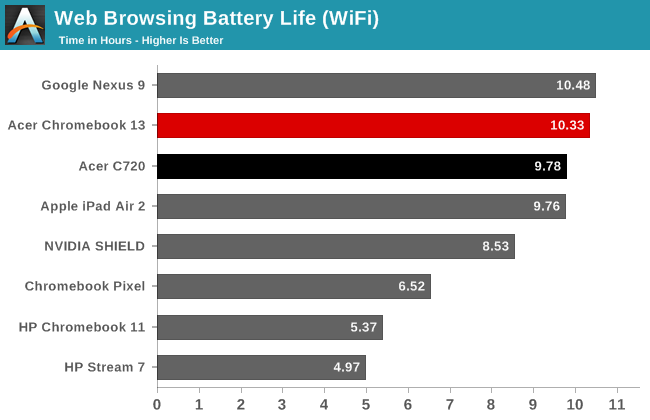
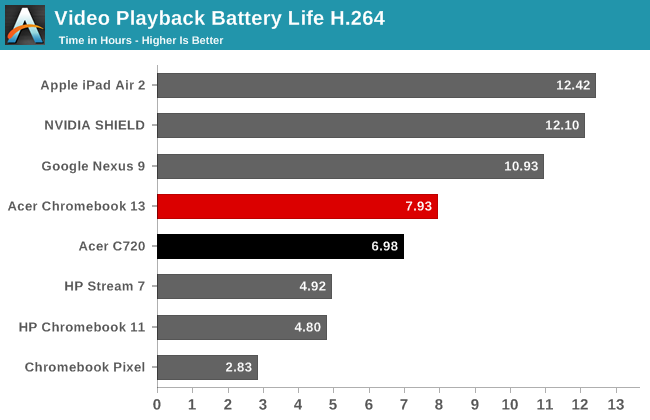
Over ten hours of battery life for web surfing is certainly nothing to scoff at, but perhaps more surprising is the nearly eight hours of video playback. Our earlier Chromebooks didn't do nearly as well, but both the C720 and the Chromebook 13 are able to hit 7+ hours of video playback. We’re still not able to match the battery life of most tablets for video playback, but compared to the old HP Chromebook 11 and the Chromebook Pixel things have obviously improved a lot.
LCD Quality
While performance was perhaps suspect with the Tegra K1 processor, where the Chromebook 13 really lets me down is in the LCD quality. I’m used to seeing a lot of poor quality 1366x768 TN panels in budget laptops, but when Acer chose to offer a 1080p display I hoped for something better. Unfortunately, the only upgraded aspect is the resolution, and the graininess and poor viewing angles at times make the display almost worse than a lower resolution panel. As you would expect, the color quality and accuracy also leave much to be desired.
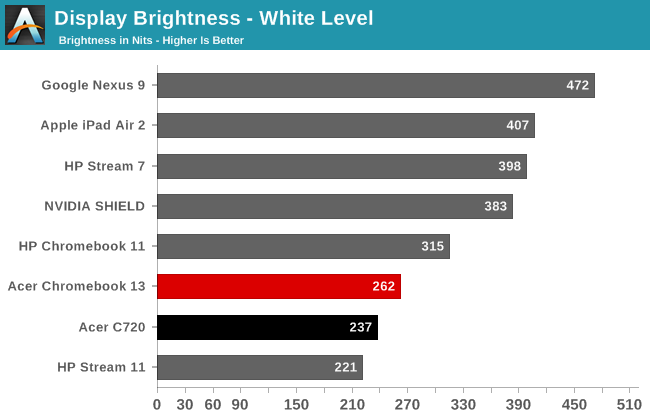
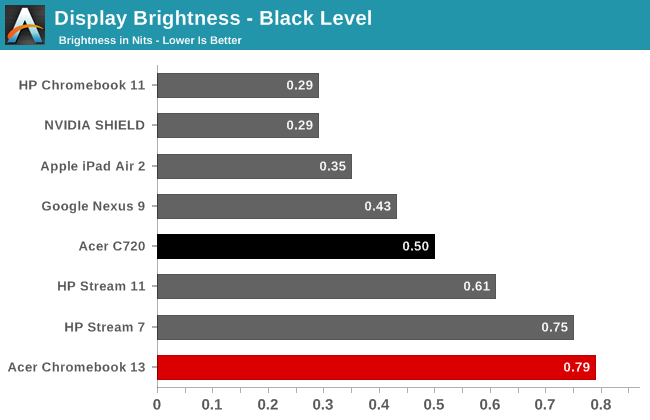
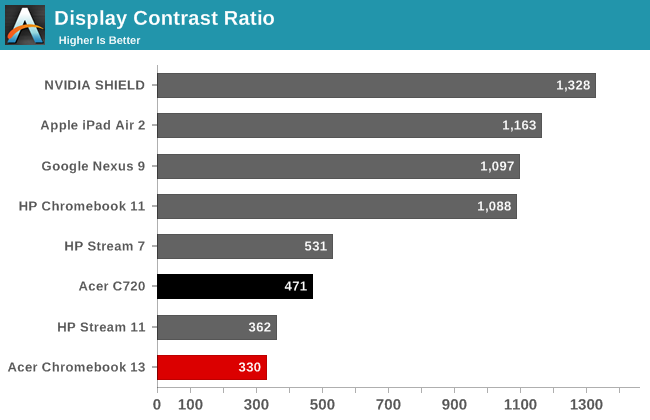
Right from the start we see problems with the display. The maximum white level of 262 nits isn’t horrible, but the corresponding black level of 0.79 nits is more of a dark grey than a black, and the resulting contrast is a rather poor 330:1 at best. And I say “at best” because at lower intensities the contrast drops further, e.g. when set for 200 nits we measured a black level of 0.67, giving us a 298:1 contrast ratio (and at 100 nits the contrast is only 65:1).
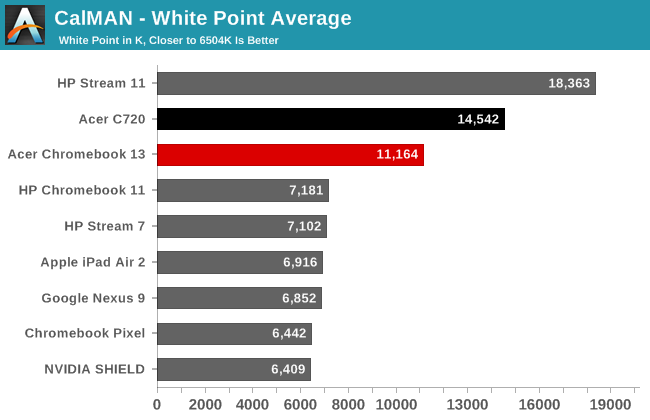
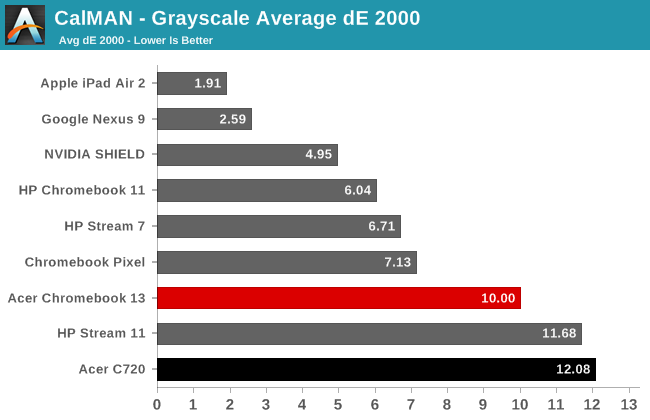
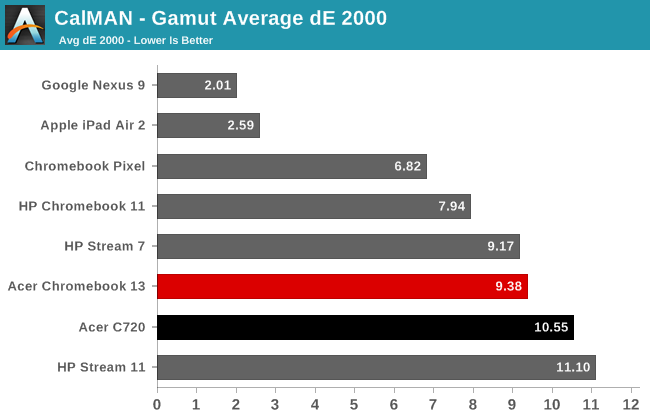

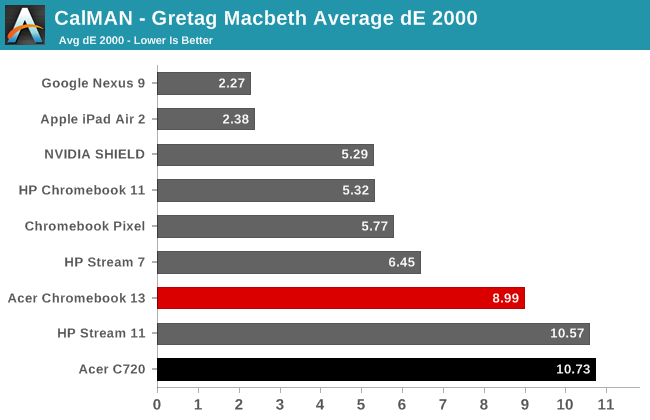
Things don’t improve as we move to other areas. The white point is crazy high at 11164K, though not at the level of the HP Stream 11 (thank goodness) and the result is that the screen – whites/greys in particular – has a clear “cool” blue tint. Delta E results across the whole set of tests are generally at or above 9.0 averages, which means the errors are very clearly visible to the naked eye. Here’s what the comparison charts look like for what you see vs. what you should see:
In this sense, it’s almost the reverse of the last Chromebook we reviewed, the HP CB11, where we found a good display (relatively speaking) but other areas needed work. The C720 display is another good point of comparison here: it has worse maximum brightness and colors are even less accurate, but the contrast ratio is slightly better at 471:1. As I said earlier, it’s like one step forward in resolution, but a step laterally or even backwards in other areas.
We can almost excuse the poor display as the Chromebook 13 is a budget laptop, and while there are plenty of Chromebooks around the $250 price point, the only current option that has a good display (other than the too-expensive Pixel) is Toshiba’s Chromebook 2 with a 1080p IPS panel. At $100 more for the Toshiba it’s unfortunately going to be a tough pill to swallow. Again, Acer seems to have learned a lesson here with upgraded displays as the forthcoming CB15 1080p uses an IPS panel. We should have both the Toshiba CB2 and the Acer CB15 in for testing shortly, so I can see how the two truly stack up in other areas, but for now if you like high quality displays just know that this particular 1080p panel falls well short of that mark. Not that my mom would likely notice the difference unless I pointed it out, of course….


_thumb.jpg)
_thumb.jpg)
_thumb.jpg)
_thumb.jpg)
_thumb.jpg)











71 Comments
View All Comments
damianrobertjones - Friday, January 23, 2015 - link
Maybe admins need to log their family in as a local account.Either way, in my opinion, there's only a 5% reasonable point in having a chromebook even if it can do 95% of what a WIndows machine can do (Which I do not believe).
HotBBQ - Friday, January 23, 2015 - link
You seem to be missing the entire point of a Chromebook. They are low cost alternatives to full fledged laptops or tablets. I bought a refurb one for myself and use it all the time to watch Netflix, Hangouts, emails, remote desktop, browse the web, and other tasks. Sure, I could use a tablet or my phone for these things, but this format works much better for me. I liked it so much I bought one for my parents who would sit in a cramped room with an ancient Vista desktop to do Hangouts with our kids. They LOVE the Chromebook because it is dead simple.Alexvrb - Sunday, January 25, 2015 - link
But you can get full fledged laptops and tablets for the same price. So I think you're the one missing the point. The point is that they're good for someone to check email on and they're locked down tight so they're hard to screw up. Of course, that pretty much applies to modern Windows devices too now. The downside is that Win8 requires tweaking for more advanced users to be happy. Win10 looks to be pretty decent out of the box though. Unless you're just a diehard "I hate it just because also apps should die except on Android for some reason" kind of guy.talonz - Monday, January 26, 2015 - link
Have you used a chromebook? You can't get a full fledged laptop with the same speed, battery life, and portability for double the price of a chromebook.Alexvrb - Monday, January 26, 2015 - link
What does that have to do with cost? He said they're "low cost alternatives to full fledged laptops or tablets". He didn't say "well they have this or that feature!". But let's discuss these things anyway. Have you used a HP Stream 11? Compare that to the HP Chromebook 11. Same manufacturer, and largely similar hardware.Performance: Similar CPUs... but the Stream 11's N2840 has a higher turbo (200Mhz) than the N2830 in the Chromebook 11. Similar situation for graphics turbo. Both have 2GB of RAM, although Windows has excellent virtual memory support in case you really load up lots of tabs (ask the Anandtech authors, has been discussed before). ChromeOS uses less space so 16GB might not be the end of the world, but Stream has 32GB - not to mention recent Win 8.1 deployments have crunched down the footprint which means more space available on the Stream. Whoops.
Battery life? HP rates their Stream 11 at 8 hours 15 minutes on a 37Wh battery, and rates their Chromebook 11 at 8 hours on a 36Wh battery. Portability? The Stream 11 is the same size, only a hair thinner, and a hair lighter. Display? Same display. Whoops.
So clearly the Chromebook is cheaper? Nope. $199 for the Stream 11, $279 for the Chromebook 11. Whoops!
Alexey291 - Sunday, February 1, 2015 - link
And then we face reality. Have you actually tried using that "lower footprint" win8.1 on a n2840? I have. I'd rather never do that again. Because the footprint is so low that the system just freezes for seconds at a time. Windows performance tax has only increased with the years.Win8.1 install takes up 25 - 27 gb of roughly 30gb (post ntfs format) space. Enjoy your 3 - 4 gb of usable space. And yeah that v-mem is going to take the remaining 2/3 of that space. gg
Oh you will now say "get rid of the bloat". No no mate that's not how a pc for a grandmother works. You get what u paid for and you suffer with it.
And then u still have to have an AV suite, a firewall and a malware scanner running in the background. Cos you know. Windows.
azazel1024 - Monday, February 2, 2015 - link
Me thinks you are doing it wrong. That or maybe/possibly you have a large restore partition there. Including page file and hibernation file, a 32GB Windows 8.1 install, including all updates and the big update 1 (once cleaned up) should leave approximately 11GiB of free space with 32GB (~29 odd GiB) of storage. That isn't a ton of space, but should be plenty to install a fair number of windows store apps. Then load on an SD card or something for media and desktop applications.I'd still say the minimum for a "real" machine should be 60/64GB, if not double, but you can do it with 32GB without being a serious issues (heck, my laptop currently has a 32GB mSATA drive as its boot drive and it has 9.8GiB free with fully up-to-date Windows 8.1 on it and a few programs installed, though most stuff is on the 120GB 2.5" SSD in the drive bay).
stefstef - Friday, January 23, 2015 - link
i agree. with the new low power, low cost Atom machines with Windows and the pricepoint at around 300 (even cheaper for tablets), the Chrome os hardly makes sense any more.syxbit - Friday, January 23, 2015 - link
You're still missing the point. It's not just the price. It's the simplicity. My wife used to constantly get viruses, crash things, have to do data backups etc..Now she has a chromebook, and it just works.
jabber - Friday, January 23, 2015 - link
And that is what a great deal of the computing public out there want. As much as we enthusiasts love out Windows machines, most really don't care and just want to get on with their day without being stopped by Trovi/Ask Toolbars and constant updates getting in the way. Unless Microsoft really knuckle under and make Windows 10 onwards far more idiot and bullet proof they really may as well give up in the domestic/home market.